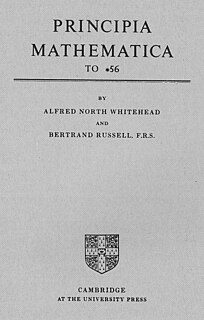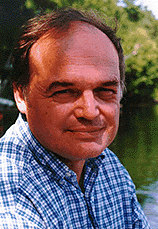Related Research Articles
In philosophy and logic, the classical liar paradox or liar's paradox or antinomy of the liar is the statement of a liar that they are lying: for instance, declaring that "I am lying". If the liar is indeed lying, then the liar is telling the truth, which means the liar just lied. In "this sentence is a lie" the paradox is strengthened in order to make it amenable to more rigorous logical analysis. It is still generally called the "liar paradox" although abstraction is made precisely from the liar making the statement. Trying to assign to this statement, the strengthened liar, a classical binary truth value leads to a contradiction.
Mathematical logic is the study of formal logic within mathematics. Major subareas include model theory, proof theory, set theory, and recursion theory. Research in mathematical logic commonly addresses the mathematical properties of formal systems of logic such as their expressive or deductive power. However, it can also include uses of logic to characterize correct mathematical reasoning or to establish foundations of mathematics.

Alfred Tarski was a Polish-American logician and mathematician. A prolific author best known for his work on model theory, metamathematics, and algebraic logic, he also contributed to abstract algebra, topology, geometry, measure theory, mathematical logic, set theory, and analytic philosophy.

Metamathematics is the study of mathematics itself using mathematical methods. This study produces metatheories, which are mathematical theories about other mathematical theories. Emphasis on metamathematics owes itself to David Hilbert's attempt to secure the foundations of mathematics in the early part of the 20th century. Metamathematics provides "a rigorous mathematical technique for investigating a great variety of foundation problems for mathematics and logic". An important feature of metamathematics is its emphasis on differentiating between reasoning from inside a system and from outside a system. An informal illustration of this is categorizing the proposition "2+2=4" as belonging to mathematics while categorizing the proposition "'2+2=4' is valid" as belonging to metamathematics.

George Stephen Boolos was an American philosopher and a mathematical logician who taught at the Massachusetts Institute of Technology.
In set theory, a branch of mathematics, an urelement or ur-element is an object that is not a set, but that may be an element of a set. It is also referred to as an atom or individual.
Kenneth Jon Barwise was an American mathematician, philosopher and logician who proposed some fundamental revisions to the way that logic is understood and used.
In logic, a true/false decision problem is decidable if there exists an effective method for deriving the correct answer. Zeroth-order logic is decidable, whereas first-order and higher-order logic are not. Logical systems are decidable if membership in their set of logically valid formulas can be effectively determined. A theory in a fixed logical system is decidable if there is an effective method for determining whether arbitrary formulas are included in the theory. Many important problems are undecidable, that is, it has been proven that no effective method for determining membership can exist for them.
Non-well-founded set theories are variants of axiomatic set theory that allow sets to be elements of themselves and otherwise violate the rule of well-foundedness. In non-well-founded set theories, the foundation axiom of ZFC is replaced by axioms implying its negation.
In logic and mathematics, a formal proof or derivation is a finite sequence of sentences, each of which is an axiom, an assumption, or follows from the preceding sentences in the sequence by a rule of inference. It differs from a natural language argument in that it is rigorous, unambiguous and mechanically verifiable. If the set of assumptions is empty, then the last sentence in a formal proof is called a theorem of the formal system. The notion of theorem is not in general effective, therefore there may be no method by which we can always find a proof of a given sentence or determine that none exists. The concepts of Fitch-style proof, sequent calculus and natural deduction are generalizations of the concept of proof.

John Richard Perry is Henry Waldgrave Stuart Professor of Philosophy Emeritus at Stanford University and Distinguished Professor of Philosophy Emeritus at the University of California, Riverside. He has made significant contributions to philosophy in the fields of philosophy of language, metaphysics, and philosophy of mind. He is known primarily for his work on situation semantics, reflexivity, indexicality, personal identity, and self-knowledge.
Originally the expression Universal logic was coined by analogy with the expression Universal algebra. The first idea was to develop Universal logic as a field of logic that studies the features common to all logical systems, aiming to be to logic what Universal algebra is to algebra. A number of approaches to universal logic in this sense have been proposed since the twentieth century, using model theoretic, and categorical approaches. But then the Univeral Logic Project developed as a general universal logic project including this mathematical project but also many other logical activities.

John W. Etchemendy is an American logician and philosopher who served as Stanford University's twelfth Provost. He succeeded John L. Hennessy to the post on September 1, 2000 and stepped down on January 31, 2017.
Fitch notation, also known as Fitch diagrams, is a notational system for constructing formal proofs used in sentential logics and predicate logics. Fitch-style proofs arrange the sequence of sentences that make up the proof into rows. A unique feature of Fitch notation is that the degree of indentation of each row conveys which assumptions are active for that step.
In situation theory, situation semantics attempts to provide a solid theoretical foundation for reasoning about common-sense and real world situations, typically in the context of theoretical linguistics, theoretical philosophy, or applied natural language processing,
Laurence Robert Horn is an American linguist. He is Professor Emeritus of Linguistics in the Department of Linguistics at Yale University with specialties in pragmatics and semantics. He received his doctorate in 1972 from UCLA and formerly served as Director of Undergraduate Studies, Director of Graduate Studies, and Chair of the Yale Department of Linguistics. In 2021, he served as President of the Linguistic Society of America.
Language, Proof and Logic is an educational software package, devised and written by Jon Barwise and John Etchemendy, geared to teaching formal logic through the use of a tight integration between a textbook and four software programs, where three of them are logic related and the other (Submit) is an internet-based grading service. The name is a pun derived from Language, Truth, and Logic, the philosophy book by A. J. Ayer.
In predicate logic, existential generalization is a valid rule of inference that allows one to move from a specific statement, or one instance, to a quantified generalized statement, or existential proposition. In first-order logic, it is often used as a rule for the existential quantifier in formal proofs.
In propositional logic, tautological consequence is a strict form of logical consequence in which the tautologousness of a proposition is preserved from one line of a proof to the next. Not all logical consequences are tautological consequences. A proposition is said to be a tautological consequence of one or more other propositions in a proof with respect to some logical system if one is validly able to introduce the proposition onto a line of the proof within the rules of the system and in all cases when each of those one or more other propositions are true, the proposition also is true.
Logical consequence is a fundamental concept in logic, which describes the relationship between statements that hold true when one statement logically follows from one or more statements. A valid logical argument is one in which the conclusion is entailed by the premises, because the conclusion is the consequence of the premises. The philosophical analysis of logical consequence involves the questions: In what sense does a conclusion follow from its premises? and What does it mean for a conclusion to be a consequence of premises? All of philosophical logic is meant to provide accounts of the nature of logical consequence and the nature of logical truth.
References
- ↑ Goldson, D., (1994) Review of The Language of First-Order Logic, including the Macintosh Program Tarski's World. The Philosophical Quarterly, 44, 175, 272–275.
- ↑ Fallis, D.,(1999). Review of The Language of First-Order Logic, Including the IBM-Compatible Windows Version of Tarski's World 4.0. Journal of Symbolic Logic, 64, 2, 916–918.
- ↑ Compton, K. J., (1993). Review of The Language of First-Order Logic, including the Program Tarski's World. Journal of Symbolic Logic, 58, 1, 362–363.
- ↑ Bailhache, P.(1992). Review of The Language of First-Order Logic, Including the Macintosh™ Tarski's World. Studia Logica, 51, 1, 145–147.
- ↑ Goldson, D., Reeves, S. and R. Bornat (1993) A Review of Several Programs for the Teaching of Logic, The Computer Journal, Volume 36, Issue 4, pp. 373-386.
- ↑ Barwise, Jon; Etchemendy, John (1992). "Hyperproof: Logical Reasoning with Diagrams". AAAI Technical Report SS-92-02.